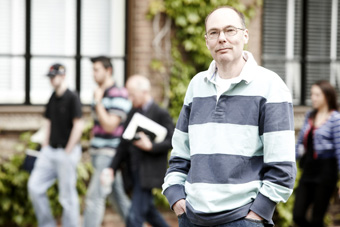Home > Press > Research creates nanoparticles perfectly formed to tackle cancer
 |
| Dr Ross Boyle |
Abstract:
Researchers from the University of Hull have discovered a way to load up nanoparticles with large numbers of light-sensitive molecules to create a more effective form of photodynamic therapy (PDT) for treating cancer.
Research creates nanoparticles perfectly formed to tackle cancer
Hull, UK | Posted on June 6th, 2011Photodynamic therapy uses molecules which, when irradiated with light, cause irreparable damage to cells by creating toxic forms of oxygen, called reactive oxygen species.
Most PDT works with individual light-sensitive molecules - but the new nanoparticles could each carry hundreds of molecules to a cancer site.
A number of different light-sensitive molecules - collectively known as photosensitisers - are used in PDT and each absorbs a very specific part of the light spectrum. The research team - from the University of Hull's Department of Chemistry - placed one kind of photosensitiser inside each nanoparticle and another on the outside, which meant that far more reactive oxygen species could be created from the same amount of light. The findings are published in the current issue of Molecular Pharmaceutics.
The nanoparticles have also been designed to be the perfect size and shape to penetrate easily into the tumour, as lead researcher, Dr Ross Boyle, explains.
"Small cancer tumours get nutrients and oxygen by diffusion, but once tumours reach a certain size, they need to create blood vessels to continue growing, " he says. "These new blood vessels, or neovasculature, are ‘leaky' because the vessel walls are not as tightly knit as normal blood vessels. Our nanoparticles have been designed so the pressure in the blood vessels will push them through the space between the cells to get into the tumour tissue."
The nanoparticles are made from a material that limits the leaching of its contents while in the bloodstream, but when activated with light, at the tumour, the toxic reactive oxygen species can diffuse freely out of the particles; meaning that damage is confined to the area of the cancer.
The researchers tested the nanoparticles on colon cancer cells, and while they were able to penetrate the cells, they also found that the nanoparticles could still be effective when near - rather than inside - the cancer cells.
"Some types of cancer cell are able to expel conventional drugs, so if we can make this kind of therapy work simply by getting the nanoparticles between the cancer cells, rather than inside them, it could be very beneficial," says Dr Boyle.
####
For more information, please click here
Contacts:
For media enquiries please contact:
Claire Mulley
01482 466943 or
07809 585965
or
Abigail Chard, Campus PR
0113 258 9880 or
07960 448532
Copyright © The University of Hull
If you have a comment, please Contact us.Issuers of news releases, not 7th Wave, Inc. or Nanotechnology Now, are solely responsible for the accuracy of the content.
| Related News Press |
News and information
![]() Researchers develop molecular qubits that communicate at telecom frequencies October 3rd, 2025
Researchers develop molecular qubits that communicate at telecom frequencies October 3rd, 2025
![]() Next-generation quantum communication October 3rd, 2025
Next-generation quantum communication October 3rd, 2025
![]() "Nanoreactor" cage uses visible light for catalytic and ultra-selective cross-cycloadditions October 3rd, 2025
"Nanoreactor" cage uses visible light for catalytic and ultra-selective cross-cycloadditions October 3rd, 2025
Nanomedicine
![]() New molecular technology targets tumors and simultaneously silences two ‘undruggable’ cancer genes August 8th, 2025
New molecular technology targets tumors and simultaneously silences two ‘undruggable’ cancer genes August 8th, 2025
![]() New imaging approach transforms study of bacterial biofilms August 8th, 2025
New imaging approach transforms study of bacterial biofilms August 8th, 2025
![]() Cambridge chemists discover simple way to build bigger molecules – one carbon at a time June 6th, 2025
Cambridge chemists discover simple way to build bigger molecules – one carbon at a time June 6th, 2025
![]() Electrifying results shed light on graphene foam as a potential material for lab grown cartilage June 6th, 2025
Electrifying results shed light on graphene foam as a potential material for lab grown cartilage June 6th, 2025
Discoveries
![]() Researchers develop molecular qubits that communicate at telecom frequencies October 3rd, 2025
Researchers develop molecular qubits that communicate at telecom frequencies October 3rd, 2025
![]() Next-generation quantum communication October 3rd, 2025
Next-generation quantum communication October 3rd, 2025
![]() "Nanoreactor" cage uses visible light for catalytic and ultra-selective cross-cycloadditions October 3rd, 2025
"Nanoreactor" cage uses visible light for catalytic and ultra-selective cross-cycloadditions October 3rd, 2025
Announcements
![]() Rice membrane extracts lithium from brines with greater speed, less waste October 3rd, 2025
Rice membrane extracts lithium from brines with greater speed, less waste October 3rd, 2025
![]() Researchers develop molecular qubits that communicate at telecom frequencies October 3rd, 2025
Researchers develop molecular qubits that communicate at telecom frequencies October 3rd, 2025
![]() Next-generation quantum communication October 3rd, 2025
Next-generation quantum communication October 3rd, 2025
![]() "Nanoreactor" cage uses visible light for catalytic and ultra-selective cross-cycloadditions October 3rd, 2025
"Nanoreactor" cage uses visible light for catalytic and ultra-selective cross-cycloadditions October 3rd, 2025
Photonics/Optics/Lasers
![]() ICFO researchers overcome long-standing bottleneck in single photon detection with twisted 2D materials August 8th, 2025
ICFO researchers overcome long-standing bottleneck in single photon detection with twisted 2D materials August 8th, 2025
![]() Institute for Nanoscience hosts annual proposal planning meeting May 16th, 2025
Institute for Nanoscience hosts annual proposal planning meeting May 16th, 2025
|
|
||
|
|
||
| The latest news from around the world, FREE | ||
|
|
||
|
|
||
| Premium Products | ||
|
|
||
|
Only the news you want to read!
Learn More |
||
|
|
||
|
Full-service, expert consulting
Learn More |
||
|
|
||








